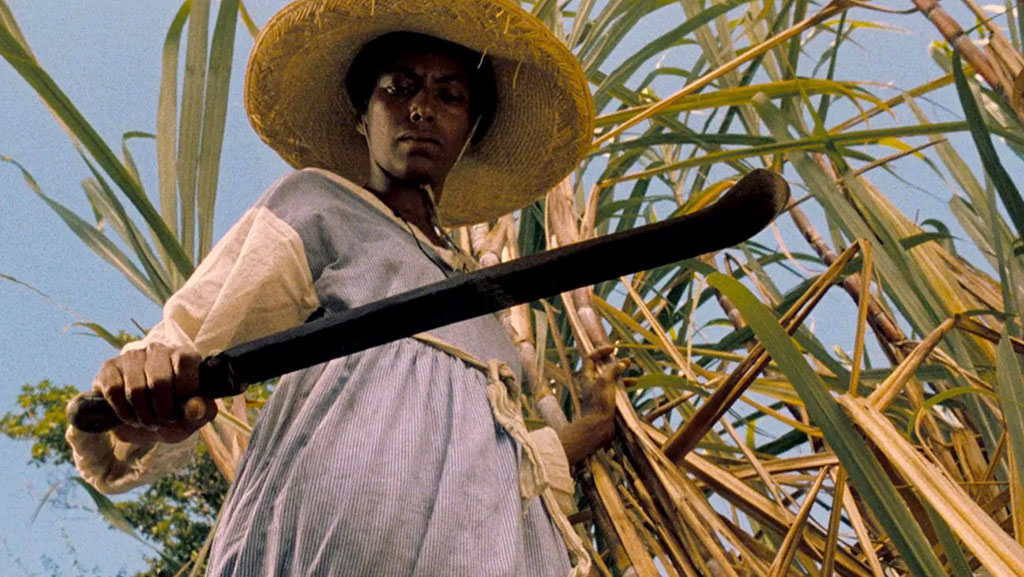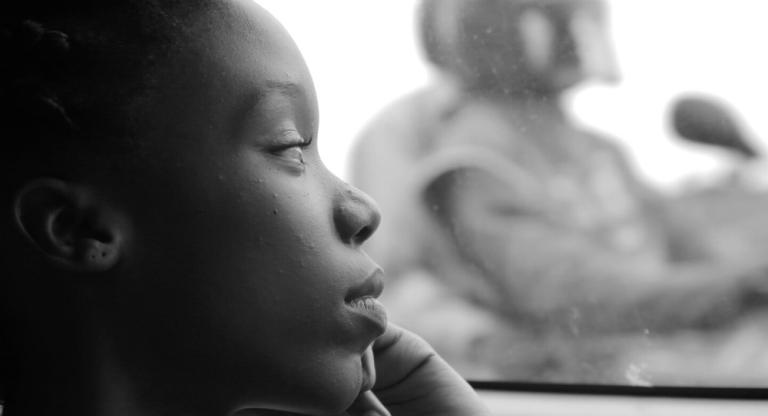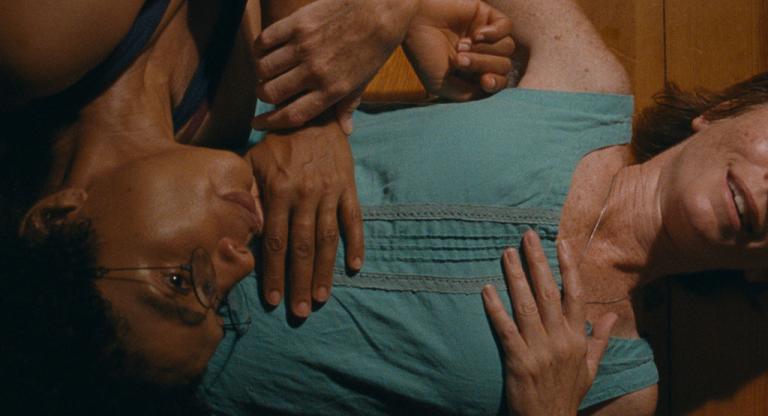Across a career spanning almost fifty years, the Ethiopian professor and filmmaker Haile Gerima has explored the aesthetics of resistance in the Black imagination. His films have investigated Black desire and resistance practices against white violence, following the ways in which displaced Black people—in local and global contexts—carry their narratives through containment and erasure.
Gerima’s Sankofa (1993) is playing as part of the ongoing film series curated by Natacha Nsabimana for the African Film Institute and e-flux Screening Room. The series invites filmmakers, artists, and scholars to meditate on and discuss “African Cinema.” Tonight’s screening will be followed by a conversation between filmmaker Merawi Gerima (son of Haile) and the scholar Honey Crawford. The film takes viewers from a beach in contemporary Ghana, to Cape Coast Castle, to scenes of resistance and rebellion on a plantation in the American South. Gerima’s magnanimous tale collapses the global and temporal distances of collective Black struggle by intersticing the past and present into a metronome, represented through the image and sound of a drum that recurs throughout the film.
Sankofa is an epic and formally ambitious film about a plantation slave revolt that spans centuries, but it was initially ignored by U.S. distributors. This led Gerima to organize with Black communities in the U.S. and book sold-out screenings in independent theaters across the country. In an interview with Reelblack in 2015, he said: “We testify for displaced people because we’ve lost a grip of our own story. All humans have to express their stories. When you don’t tell your story you’ll be a confused human being forever. White power structures sustains its own continuity; they are very greedy. White power is a very undeclared, silent, confident domination of the world in globalization terms; they don’t have to assert, we live in their dictionary. Our desire is held hostage.”
Sanfoka’s expressionist aesthetics and rich soundtrack generate a cinematic space for creative acts of Black intimacy, desire, and resistance. The film opens with the sound of an unbroken, thunderous drum and an image of a ceramic deity. From here, we meet a Black American fashion model named Mona (Oyafunmike Ogunlano) who is working on a photo shoot on the shores of Cape Coast, Ghana. In a vision, Mona is first confronted by “Sankofa,” a man who has appointed himself protector of the Cape Coast Castle—also known as “the slave castles of Ghana”—and whose name means "to retrieve" in Twi. He admonishes her, repeating: “Back to your past! Return to your source!” This opens the door for Gerima to connect Mona to the story of her ancestor, Shola (also played by Ogunlano), who is shown being taken by slave-catchers.
It is during Shola’s opening scene on the plantation that discussions about plotting against the white masters begin. Shola becomes a narrator for the lives of those on the plantation with her: Shango (Mutabaruka), a renegade field worker who uses medicine for rebellious practices; Nunu (Alexandra Duah), a griot with special mystical powers who recalls her life in Africa before she was kidnapped and terrorized by European traders; Joe (Nick Medley), the favorite of the plantation’s white priest; and Noble Ali (Afemo Omilami), who is forced to serve—and struggles with his position—as overseer. At the end of the film, during her attempt to escape the plantation, Shana narrates her death after having transformed into a bird—a symbol of trust and rebellion first given to her by Shango in the form of a gift. This brings her back to herself as Mona. Back in Ghana, but reborn and now harboring both ancestral perspectives as well as newfound ones, it becomes clear that all of Gerima’s narrative disorientations were always in service of a precise vision of self-fulfillment.
Training his camera to the study of space, social relations, gender, and power in the Old South, Gerima examines the everyday containment and movement of enslaved men and, especially, enslaved women. Sankofa brings aesthetics of Black resistance into the cinematic arena, revealing an important and historically neglected culture of opposition in Black American history through cropped shots detailing everyday caretaking practices between characters; the exchange and currency of medicinal practices and prayers; and the collective witnessing of omnipresent violence. His camera delivers the details of landscapes: red-lined sunsets, unpeopled grasslands, swamps, and the crevices of the caves in which the characters gather for leisure and gossip. At times, crossfades between shots meld his characters' faces with the sky and landscape around them, as if giving us respite from the harshly-lit sun of the plantation and the violence that takes place beneath it. Yet Gerima doesn't glorify the enforced labor and violence that he shows on-screen. Instead, he shows how romance is a conduit for knowledge production vis-a-vis extant structures of racial and sexual violence. It is through Lucy, an enslaved field woman who falls in love with Joe, a light-skinned enslaved man, that the film introduces a question that points to the contradictions of racial violence and love: “Ain't I woman enough?” she yells at him, once he throws her out of his room for touching his Virgin Mary necklace. Gerima’s notion of resistance to white violence spins on the axis of love and intimacy, asking: to what extent can love, too, be headquartered and contained?
The desire, love, and caretaking between the enslaved people on the plantation takes on a urgent tone in Sankofa, marked by each character’s proximity to white power, their relationship to rebellion, and to racial anxiety. Gerima outlines how love and pleasure are always marked by enslavement in this context, while also showing how Black people refused to submit to the logic of the slave system. When Nunu takes on the role of mother for a miracle-child born in the aftermath of the child’s mother’s beating, Noble expresses desire to have children with Nunu: “Don’t you think I’m tired of being a head man for the white man and the burden that comes along with it? [...] The choice is either to be a true man, or a beast.” Later, when Nunu returns from a slave auction, she takes up Noble in a sweet and triumphant embrace; in scenes like these, Gerima’s strokes of humanity give the viewer respites from the brutality of the highly-surveilled plantation life.
“They could not sell me! I was too old to be bought, too old to be sold,” Nunu says after her embrace with Noble. Enclosed in her smile, and her mimicry of the slave-auction sellers, is a forbidden kind of liberation. Although love will not protect her from the cruelty of white power, it becomes a possibility for freedom and for humanity, even if for a brief moment, to multiply in its existence. In her continued resistance to social enclosure and the watchfulness of her masters—anointing her comrades with spiritual blessings, braiding Shala’s hair, and plotting and preparing to revolt against their masters—Nunu, and the love she surrounds herself with, represents her life as an expansive one, made for herself and her beloved’s collective pleasure. This is especially clear in how we first meet Nunu. Brimming with laughter, she tells a story to a group of women circled around her in which her own laugh, literally multiplied, sets off a chain of laughter that ends in the death of a white master.
Sankofa screens this evening, June 27, at e-flux Screening Room, followed by a conversation with scholar Honey Crawford and Merawi Gerima.






